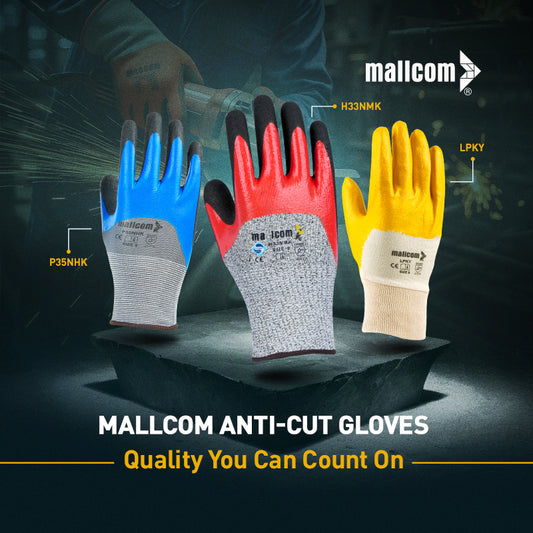Wool has been the go to fibre for cold protection during winters since ancient times. Gloves help the most crucial motor organ which is the hand and furthermore the palms and fingers to not only function smoothly in the most hostile working environments, but more importantly gloves must be treated as a crucial safety garment. Winter gloves have heavy applications in the temperate regions of earth. However, in industries these gloves have application like fisheries, cold storage, laboratories, meat industry etc. where there is a constant need for immersing the hand in a sub-zero environment.
Excessive exposure to cold weather can cause frostbit followed by frostbites on fingers. Numbness followed by frost bite and constant exposure would result in gangrene followed by hypothermia. If the frostbite isn’t addressed, it might result in death or amputation of the organ.
Insulation
The feeling of coldness or hotness is nothing but transfer of heat either from the environment to the body or from the body to the environment. This happens through the process of conduction and majorly through convection. So we flow of heat can be stopped we can prevent the loss of heat from the body. Thermos and woolen cloths are examples of the same. Air we know is a bad conductor of heat. However, air facilitates loss of heat through convection. Amazingly, air pockets on the other hand prevents flow of heat through convection. A double sided window pane or a thermos or for that matter or wool or acrylic. The common thing between all of them is the presence of air pockets.
Wool vs Acrylic vs Polyester
Much like human hair (so as for sheep hair), wool is protein fibre bundles which can be spun into yarns and hence be woven into fabrics. The key for thermal insulation is to create pockets of “still air”. The irregular structure of the wool fibre helps in making the yarns crimp which facilitates creation of air pockets.
With acrylic, the spinning method has a significant effect on the structure of PAN fibres. Fibres produced by the wet method are very porous containing a large number of microvoids of 0.1–1 μm in size and characterised by a low density between 0.4 and 0.5 g/cm3. The density of the dry-spun fibres, ranging from 0.8 to 1.17 g/cm3, is close to the density of the polymer itself which is 1.17 g/cm3. [MOD04]
Physical properties of acrylic fibre:
Tenacity: Dry= 5gm/den, wet= 4.8gm/den.
Elongation: Dry=16%, Wet= 17%.
Moisture regain: 1-2%.
Flammability: More flammable, burns rapidly with bright yellow flames.
Abrasion resistance: Good.
Dimensional stability: Good.
Colour: Dull.
Diameter: 15μm to 25µm.
Feel
It might always be a dilemma as to which fibre to go for when we have to select winter gloves for industrial wear. An industrial work wear is mostly accompanied with Nitrile Coating on top of the liner to provide the glove with substantial grip. The chemical formulation can be represented as NBR (Nitrile Butadiene Rubber).
Since wool absorbs much more moisture than Acrylic, the comparison of wool and acrylic in humid conditions can be tricky. Acrylic and Polyfil have also been a recent pick because of its vegan nature and categorised as a product which doesn’t come from animals. Since acrylic doesn’t pill as much as wool, acrylic can be “raised” or “brushed” to give a soft feel.
Polyfill
Research reveals the effectiveness of synthetic insulating materials for protection against cold. Polyester wadding/batting or popularly termed as Polyfil are the first choice for protective garments to be used in extremely cold conditions for example glaciers and extremely high altitude. Selection of material is based on i) minimising heat loss from the body to the environment, so that the metabolic heat generated from the body is not lost to the environment). ii) Simultaneously, the material should allow evaporation of sweat from the body to the environment. Sweat gets accumulated on the skin and in extreme cold conditions, the sweat gets frozen and can cause frostbite. [PRA21]
ASTM D 1518 - TOG Value
Derived from old Roman “toga” which mean garment, TOG rating or tog value refers to the thermal insulation offered by a garment or piece of cloth. TOG value is considered a standard measure of thermal rating in the US market as the TOG value is defined in the standard ASTM D 1518. The TOG value is calculated as follows:
Here, we have to introduce a unit of measurement called RSI ; where 1 RSI = temperature difference (in oC or K) between two surfaces with 1 watt heat flowing through 1 m2 area of the same during a period of 30 min.
Unit of RSI = m2.K/W
TOG value = 10 RSI; So 1 TOG = 0.1 RSI
Acrylic gloves range between about 3 to 4 TOG value
Air resistant
Wind-resistant and wind-proof properties of a fabric can be determined by the air permeability under a prescribed air pressure differential between the two surfaces of a material. The air flow rate passing perpendicularly through a given area of fabric is measured at a given pressure difference across the fabric test area over a given time period. The applicable methods include:
- ASTM D737
- ISO 9237
- GB/T 5453
- CNS 5612
- JIS L1096 8.26.1.A
- KS K 570
Air resistance is a key feature in temperate region weather where the real feel temperature drops significantly due to flow of chilling air. To prevent flow of air and water, wind proof membranes can be added along with fleece and needle punched non-woven fabrics in the inner lining of the glove.
Water repellent vs Breathable
Perhaps a topic which deserves an article of itself. Let’s get to the basic of the theme. A smallest water droplet is in a range of 700 µ – 1000 µ (1 µ = 10-6 m). Largest vapour molecule on the other hand is in the range of 50-100 µ. Which gives us a window of around 102m to make a fabric which would not allow water to enter and at the same time allow sweat vapour to exit.
For a winter glove to be breathable is all the more important as freezing up of accumulated sweat on the palm causing frostbites are not desirable. At the same time, a blanket of still air between the hand and the atmosphere is extremely desirous to create thermal insulation.
EN511:2006
The European standard for gloves protection from cold is marked by EN 511 (EN stands for European Norm).
This standard measure how well the glove can withstand both convective cold and contact cold. In addition, water permeation is tested after 30 minutes.
- The first figure shows how well the glove protects against convective cold (performance level 0-4)
- The second figure shows how well the glove protects against contact cold (performance level 0-4)
- The third figure shows the glove protection against water penetration (performance 0 or 1 where 0 indicates “water penetration after 30 minutes” and 1 indicates “no water penetration after 5”).
|
Performance Level - contact |
Thermal Insulation (R) in m2°C/W |
Equivalent TOG value |
Recommended Temperature |
|
Level 1 |
0.025 RSI < 0.050 |
0.25 to 0.5 |
10o C |
|
Level 2 |
0.050 RSI < 0.100 |
0.5 to 1 |
0o C |
|
Level 3 |
0.100 RSI < 0.150 |
1 to 1.5 |
-15o C |
|
Level 4 |
0.150 < RSI |
1.5 and above |
-30o C |
Table 1: Comparison of ENN level with the respective TOG value and working temperature recommended
Nitrile Dipping
Acrylic winter gloves are raised from the inside to give a soft touch and coated with nitrile butadiene rubber (NBR) with/without foamy finish and with/without sandy finish on the top. The nitrile coating not only imparts chemical resistance properties like hazardous substances and toxic chemicals but also plays a major role in imparting the physical properties like slip resistance, abrasion resistance, cut and tear resistance and puncture resistance.
Bibliography
- [DFE22] : Definetextile.com
- [MAH12] : Maharul Islam Kiron – Textile learner - https://textilelearner.net/water-resistance-test-for-fabric/
- [PRA21] : Prathyusha Kantheti, Ph.D Scholar, Department of Apparel and Textiles,College of Home Science, PJTSAU, Hyderabad, India- https://textilelearner.net/clothing-for-extreme-cold-conditions-an-overview/
- [SHA21] : Shailja Sharma, M. Tech. Scholar, Department of Textile Technology, NIT Jalandhar, India.
- [ANA20] : The Anatomy of a Wool Fibre, August 7, 2020 - https://mountainmerino.com/blogs/news/the-anatomy-of-wool








